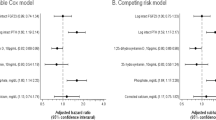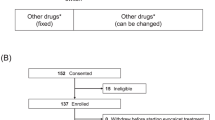Abstract
This brief article is a response to the article by Monge et al. on page 326 entitled Reappraisal of 2003 NKF-K/DOQI guidelines for management of hyperparathyroidism in chronic kidney disease patients. We contend that there is insufficient evidence to support the changes to clinical practice and clinical practice guidelines proposed by Monge and colleagues. We recommend that clinical trials be conducted to resolve these points of contention and other critical issues in the management of disorders of mineral metabolism in chronic kidney disease, including secondary hyperparathyroidism. The focus should be on evaluating the effects of alternative strategies on survival, as well as clinical manifestations of cardiovascular and bone disease.
Key Points
-
In 2003, the US National Kidney Foundation (NKF) established clinical practice guidelines for the management of disorders of mineral metabolism in chronic kidney disease patients
-
Many of the recommendations in the 2003 NKF-K/DOQI guidelines were based on expert opinion rather than data from high-quality clinical trials
-
On page 326 of this issue, Monge et al. challenge the validity of some of the NKF-K/DOQI recommendations
-
In this article, Ix et al. contend that the revised recommendations proposed by Monge et al. are currently supported by insufficient evidence
This is a preview of subscription content, access via your institution
Access options
Subscribe to this journal
Receive 12 print issues and online access
$209.00 per year
only $17.42 per issue
Buy this article
- Purchase on Springer Link
- Instant access to full article PDF
Prices may be subject to local taxes which are calculated during checkout
Similar content being viewed by others
References
Bricker NS et al. (1969) Calcium, phosphorus, and bone in renal disease and transplantation. Arch Intern Med 123: 543–553
Dusso AS (2003) Vitamin D receptor: mechanisms for vitamin D resistance in renal failure. Kidney Int Suppl 85: S6–S9
Friedman EA (2005) Consequences and management of hyperphosphatemia in patients with renal insufficiency. Kidney Int Suppl 95: S1–S7
Gotch FA et al. (2003) A kinetic model of inorganic phosphorus mass balance in hemodialysis therapy. Blood Purif 21: 51–57
Minutolo R et al. (2002) Postdialytic rebound of serum phosphorus: pathogenetic and clinical insights. J Am Soc Nephrol 13: 1046–1054
Delmez JA et al. (1982) Minerals, vitamin D, and parathyroid hormone in continuous ambulatory peritoneal dialysis. Kidney Int 21: 862–867
National Kidney Foundation (2003) K/DOQI clinical practice guidelines for bone metabolism and disease in chronic kidney disease. Am J Kidney Dis 42 (Suppl 3): S1–201
Drueke TB (2001) Control of secondary hyperparathyroidism by vitamin D derivatives. Am J Kidney Dis 37 (Suppl 2): S58–61
Henley C et al. (2005) 1,25-Dihydroxyvitamin D3 but not cinacalcet HCl (Sensipar®/Mimpara®) treatment mediates aortic calcification in a rat model of secondary hyperparathyroidism. Nephrol Dial Transplant 20: 1370–1377
Mallick NP and Berlyne GM (1968) Arterial calcification after vitamin-D therapy in hyperphosphatemic renal failure. Lancet 2: 1316–1320
Shoji T et al. (2004) Lower risk for cardiovascular mortality in oral 1α-hydroxy vitamin D3 users in a haemodialysis population. Nephrol Dial Transplant 19: 179–184
Teng M et al. (2003) Survival of patients undergoing hemodialysis with paricalcitol or calcitriol therapy. N Engl J Med 349: 446–456
Holick MF (2004) Sunlight and vitamin D for bone health and prevention of autoimmune diseases, cancers, and cardiovascular disease. Am J Clin Nutr 80 (Suppl): 1678S–1688S
Saito H et al. (2005) Circulating FGF-23 is regulated by 1α,25-dihydroxyvitamin D3 and phosphorus in vivo. J Biol Chem 280: 2543–2549
Shimada T et al. (2004) FGF-23 is a potent regulator of vitamin D metabolism and phosphate homeostasis. J Bone Miner Res 19: 429–435
Ghazali A et al. (1999) Is low plasma 25-(OH) vitamin D a major risk factor for hyperparathyroidism and Looser's zones independent of calcitriol? Kidney Int 55: 2169–2177
Sadek T et al. (2003) Sevelamer hydrochloride with or without alphacalcidol or higher dialysate calcium vs calcium carbonate in dialysis patients: an open-label, randomized study. Nephrol Dial Transplant 18: 582–588
Dusso A et al. (1988) Extra-renal production of calcitriol in chronic renal failure. Kidney Int 34: 368–375
Mowe M et al. (1999) Low serum calcidiol concentration in older adults with reduced muscular function. J Am Geriatr Soc 47: 220–226
Bischoff HA et al. (1999) Muscle strength in the elderly: its relation to vitamin D metabolites. Arch Phys Med Rehabil 80: 54–58
Dhesi JK et al. (2002) Neuromuscular and psychomotor function in elderly subjects who fall and the relationship with vitamin D status. J Bone Miner Res 17: 891–897
Pfeifer M et al. (2000) Effects of a short-term vitamin D and calcium supplementation on body sway and secondary hyperparathyroidism in elderly women. J Bone Miner Res 15: 1113–1118
Goodman WG et al. (2000) Coronary artery calcification in young adults with end-stage renal disease who are undergoing dialysis. N Engl J Med 342: 1478–1483
Guerin AP et al. (2000) Arterial stiffening and vascular calcifications in end-stage renal disease. Nephrol Dial Transplant 15: 1014–1021
Chertow GM et al. (2002) Sevelamer attenuates the progression of coronary and aortic calcification in hemodialysis patients. Kidney Int 62: 245–252
Block GA et al. (2004) Cinacalcet for secondary hyperparathyroidism in patients receiving hemodialysis. N Engl J Med 350: 1516–1525
Author information
Authors and Affiliations
Corresponding author
Ethics declarations
Competing interests
Dr Quarles has been a consultant and member of the speaker's bureau for Amgen, Inc.
Dr Chertow has served on advisory boards and has received research support from Genzyme, Inc. and Amgen, Inc.
Rights and permissions
About this article
Cite this article
Ix, J., Quarles, L. & Chertow, G. Guidelines for disorders of mineral metabolism and secondary hyperparathyroidism should not yet be modified. Nat Rev Nephrol 2, 337–339 (2006). https://doi.org/10.1038/ncpneph0190
Received:
Accepted:
Issue Date:
DOI: https://doi.org/10.1038/ncpneph0190



